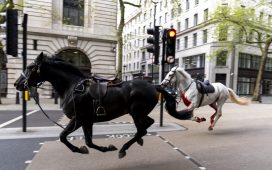Betty, a six-year-old kerry blue terrier, celebrated reaching the summit of her 282nd and final Munro – Am Basteir on Skye – with a hard-boiled egg. Her owner, Shona Marshall, toasted her dog’s entry into the rarefied class of canine completers – only 15 are registered with the Munro Society – with a mini bottle of fizz, carried up the 934-metre mountainside for the occasion.
“It really does strengthen the bond between you,” says Marshall of their 367-day challenge, completed on Good Friday, to raise funds for Kerry Blue Terrier Rescue. “They are trusting you to tell them it’s OK to cross this river or climb down this bit of rock. It’s humbling.”
Climbing Scotland’s Munros – mountains higher than 914 metres or 3,000ft – has become a hugely popular pursuit since lockdown as staycationers seek out ever more challenging beauty spots. Experts note increasing numbers are taking their dogs with them to “bag” a peak, which range from relatively straightforward day hikes to the notorious Inaccessible Pinnacle, the second highest summit in the Skye Cuillin, which requires a rock-climb and abseil to complete the ascent.
Graham Caldwell runs the Highland Hounds dog walking service, which offers weekend Munro walks as well as sessions to teach owners the skills they need to take dogs up the mountains. In eight years of business, 2022 has been the busiest so far, he says.
“With more dogs than ever on the hills, it’s about accessibility and knowledge. Do walkers have the information to keep their dogs safe? They need to know the access code [walkers have the right to roam anywhere in Scotland but must follow the Scottish outdoor access code], and plan how to manage their dog: having good recall, how they cope with distractions like livestock or other dogs, or rapid weather changes,” says Caldwell.
He advises keeping a dog on the lead most of the climb and certainly for all exposed areas: a harness saved one dog from a dangerous fall on the Devil’s Ridge on Sgùrr a’ Mhàim, he remembers.
“I’d be cautious of taking any brachycephalic [flat-faced] dogs up the hills, particularly in warmer weather,” he adds. “Otherwise I’ve found most dogs manage fine, with cockers, collies and other working breeds taking exceedingly well to the environment. I also find short-haired dogs particularly susceptible to cold conditions.”
“It is getting competitive”, admits Anne Butler, the vice-president of the Munro Society, “with people keeping their dog’s Munro tally.” Still, she has some concerns about owners taking their pets up challenging routes without sufficient preparation.
“People assume dogs are natural athletes, but they are not born with experience of the hills.” A dog may not know how to navigate a bog or a boulder field, she explains, or could be frightened by something unexpected – she recalls one who was scared of going downhill – and need time to acclimatise.
While the current obsession seems to be with Munro bagging, Butler points out many people and their canine companions are climbing other mountain lists – such as Corbetts and Grahams – which can be more of a challenge.
Butler’s five-year-old border collie, Ralph, has completed the Donalds [hills in Lowland Scotland that exceed 2,000ft] and has only seven Grahams [mountains between 2,000 and 2,500ft high, with at least 150 metres of descent on all sides] left to finish, likely becoming the first dog to do so.
“Doing Corbetts and Grahams with dogs is special because there’s hardly any people and you see the dog connecting with their environment without distraction,” she says.
“I enjoy watching the hills through my dog’s eyes: they’re so intent on the sounds and smells and so immersed in the moment.”








